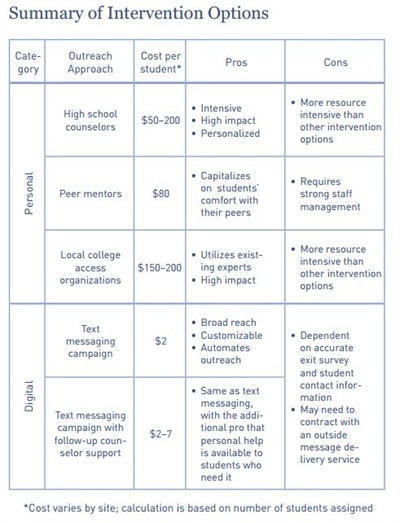Revisiting "Summer Melt": New solutions for bridging the high school to college transition
8/19/2013
As Duval County students return to school this week, this is also the time that many of last year's Duval County Public Schools graduates should be starting their college education. While many will, unfortunately many students who graduated last year intending to start college this fall likely will not.
Earlier this summer, we looked at the phenomenon of "summer melt": the attrition of seemingly college-bound graduates during the summer between high school and college. A new report out by the Harvard Strategic Data Project (SDP) takes a deeper look at this issue and offers some practical solutions for districts trying to help students bridge the gap between high school and college.
Based on studies from three large school districts and some nationally available data, the report estimates that 10-40 percent of students who graduate high school intending to enroll in college in the fall do not end up doing so. They found these rates to be higher among students from lower income families, with lower academic achievement in high school, or those intending to attend community college versus a four-year college or university.
Last year, we found that only 57 percent of DCPS graduates were enrolling in college or postsecondary education by the fall semester immediately after graduating - a percent that has remained largely unchanged over the past ten years. Some of the other 43 percent likely includes students who were never intending to attend college (an equally important but, for now, separate issue), but a portion of this number likely includes DCPS's own "summer melters."
Some of these students may have applied, been accepted, and even put a deposit down on going to college in the fall. But somewhere along the way during the summer, without the guidance support available to them in high school or after they are fully enrolled at a new postsecondary institution, many of them may become overwhelmed by the paperwork, documentation and deadlines that come along with the enrollment process and miss a key deadline or just give up. This can be especially problematic for students who are the first in their family to go to college and have no one at home with experience to help guide them through the process.
In the report, SDP offers a number of practical suggestions for ways districts can better track the postsecondary plans and actual results of their graduating students, and intervene with help equipping them to be able to bridge the gap between high school completion and college enrollment successfully.
The table below provides a summary of some of these options, but the first step in any campaign must be to accurately identify the numbers of "summer melters" in DCPS each year through student exit surveys and/or better integrated data tracking systems to be able to accurately assess student intentions and outcomes beyond high school.

Find out more by reading the full report here, and let us know what you think we can do to address "summer melt" in Duval County below.
-- Jason Rose